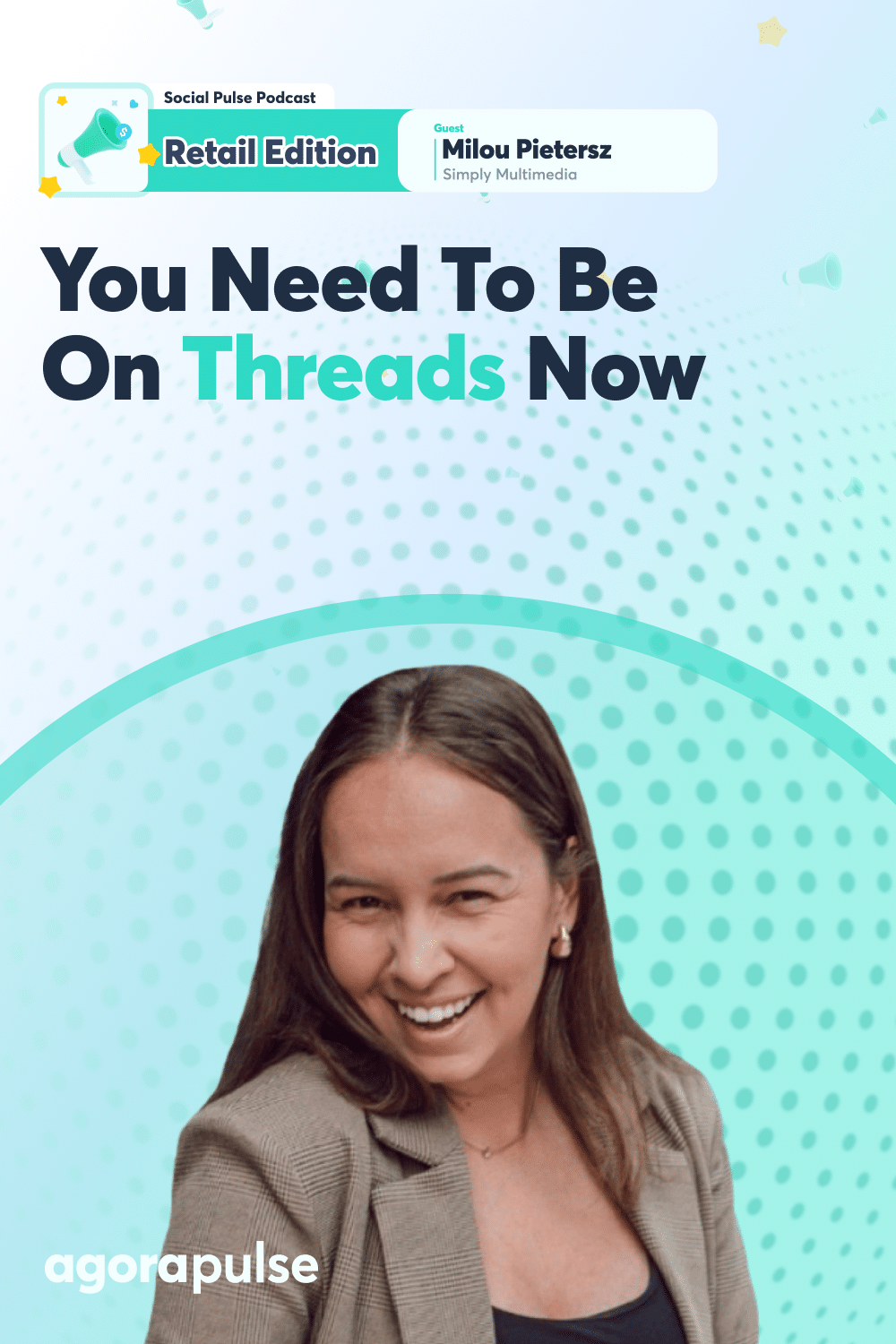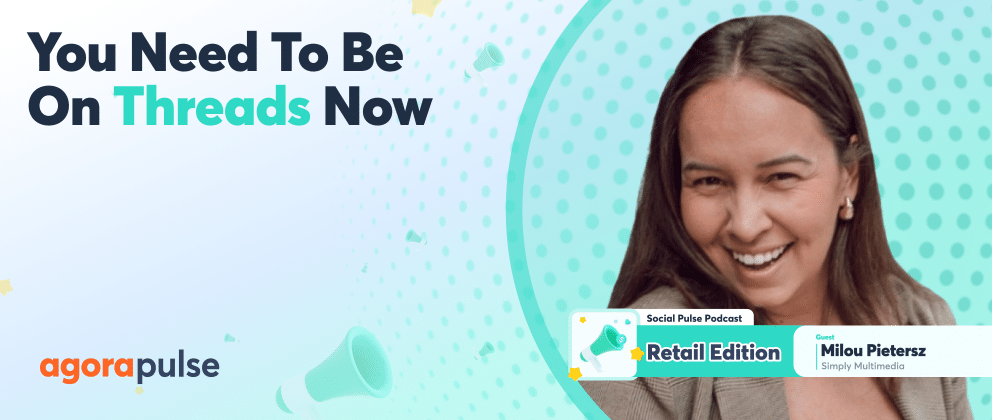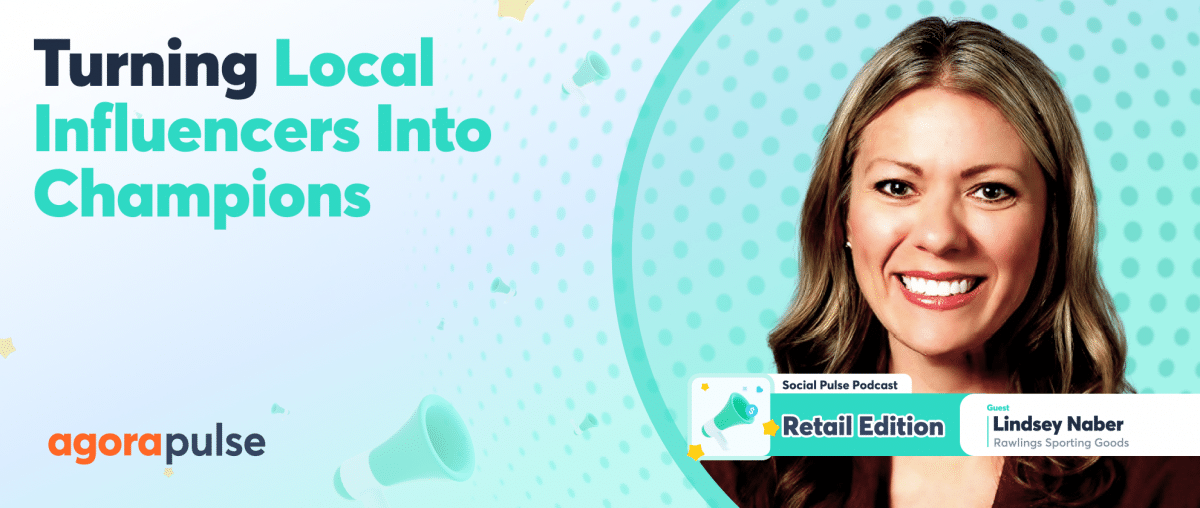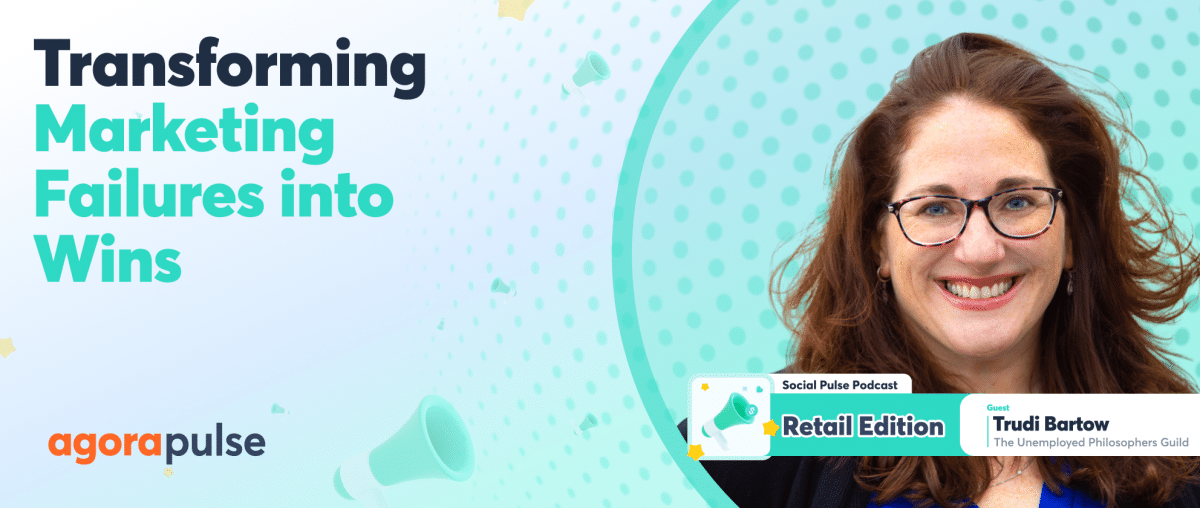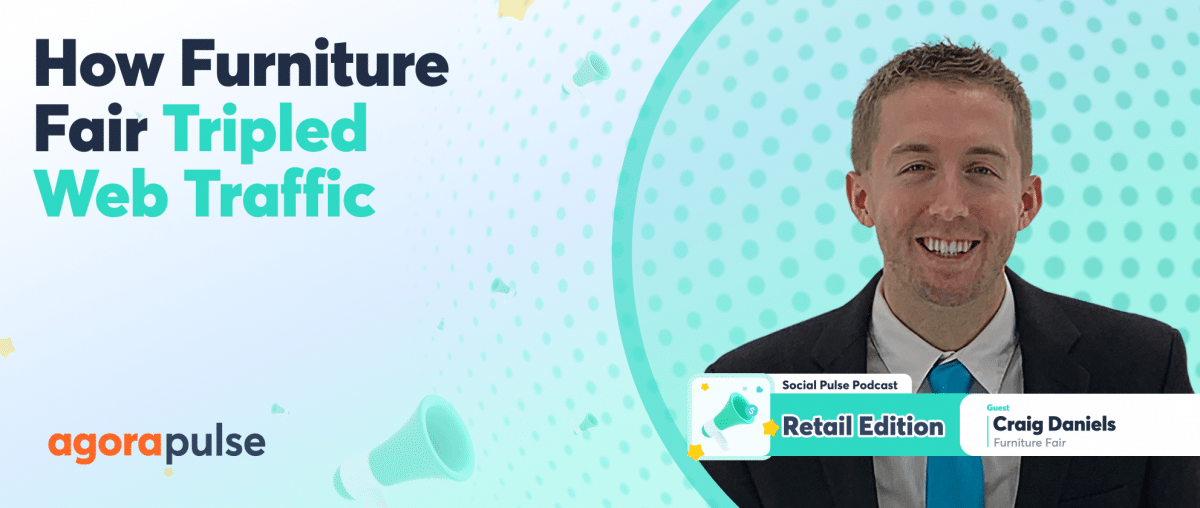If you’re a retail brand on Threads, you’ve likely been watching its evolution since its launch last summer. Maybe you created an account early on but weren’t sure what to do with it. Maybe you’re still on the fence about whether it’s worth your time, or maybe you’ve been wondering if you’ve already missed the boat.
The truth is, while platforms like Instagram and TikTok are incredibly saturated, making it harder and harder for brands to stand out, Threads represent a unique opportunity. The potential for organic reach, authentic engagement, and community building is extraordinary, but this window of opportunity won’t last forever.
Podcast guest Milou Pietersz tackles the issue in this article. She’s the founder of Simply Multimedia, a successful marketing agency that helps brands navigate the ever-evolving social media landscape. As an amazing content creator herself with over 60,000 Instagram followers and over 12,000 YouTube subscribers, Milou brings both strategic insight and hands-on experience to the table. She’s here to help us understand why Threads might be the opportunity your retail brand has been waiting for.
[Listen to the full episode below, or get the highlights of the Social Pulse: Retail Edition, powered by Agorapulse. Try it for free today.]
What makes Threads different from other social media platforms, particularly from that retail brand’s perspective?
Milou Pietersz: I think what’s different is [that] it’s very text-based first. While you can share visuals, while you can share content, and stuff like that, it’s very low effort to get started.
Quite frankly, what everyone has been saying about Threads is that it’s so easy to build genuine connections. I think that’s another big challenge for brands: how you build connections with your audience, with your communities, and have those conversations. At the same time, those conversations lead to market research for brands, even if you’re social listening on Threads and looking at other people’s conversations.
This is a way for brands of all sizes and different industries to start connecting or reconnecting with their audience and there’s not a lot of noise there because it’s text-based first. So it is all about interaction for the most part rather than, you know, an Instagram where we’re all so distracted by watching videos back to back, right?
What is unique about Threads is that you can have those real conversations.
Are you spending more time on Threads as a result because it’s all conversation and engagement?
Milou Pietersz: Honestly, creating-wise, I spend way less time on Threads versus Instagram, where you spend hours on a Reel that gets you three likes, and I spend a couple of seconds writing, my brain on Threads, and it reaches thousands of people quite literally.
I’ve talked about that quite a bit in my content as well. It’s like you’re working so hard on that one platform or you’re trying to make it work for you and in the meantime, you’re missing the boat on other opportunities like Threads where it’s very low effort to get started and to reach a lot of people, especially still right now.
What early success patterns are you seeing, specifically from retail on Threads?
Milou Pietersz: I think some success we’ve seen when we work with a lot of different brands like you say, like we have a couple of personal brands who are more retail-positioned in terms of selling products rather than just services. And they’re actually able to drive a lot of traffic also back to their Instagram. So it’s not even necessarily where, hey, you know, we’re looking to convert people of one Thread, right, or they see this Thread, and it blows up.
Instead, it’s so interconnected with Instagram already, so if you as a retail brand are already on Instagram, this only boosts you even more because they’re almost like the same platform.
Patterns I’ve seen with those two platforms are that Threads get suggested in Instagram feeds. They get notifications in people’s feeds: “Hey, you have new followers or new trends to look at.” And so obviously there was a big push from Instagram, too.
Make Threads work and intertwine the two platforms and also you’re not starting completely from scratch. If you already had an Instagram audience, you brought that over to Threads as they did that on purpose where you didn’t have to start completely from scratch.
Those are some early wins where specifically brand awareness is huge because you can bring that traffic over to Instagram to continue that funnel and convert them into whatever product or service you’re then trying to promote.
I’m actually not necessarily pushing them to Instagram. It’s all because at the same time, what I noticed is Instagram is going to push me to them anyway if they interact with me, I noticed that for myself as well when I’m interacting with someone on Threads, you know, the next moment I’m on Instagram, scrolling reels.
And their profile pops up. I don’t follow them, but I engage with them. So that’s no coincidence, right? And then typically what I would use it for is more brand awareness. People who find me recognize me on other platforms … I started to recognize a bunch of people from LinkedIn on Threads because of the brand recognition in terms of your photo, whether it’s your logo. And you deepen that connection. It’s like, “Hey, I recognize you from LinkedIn. We haven’t quite talked a lot, but now we’re interacting and having fun on Threads.”
At the same time, I’ve noticed when I talk to other people, people who follow me on Threads don’t necessarily follow me on Instagram.
I think that’s actually a good thing. Because it’s a completely different type of content to consume, right? I don’t blame people for not wanting to always be in all the feeds with all the creative. Though the videos you have to watch you have to consume the carousels.
Instead, they just want access to your brain and your thoughts and how you think—which is so unique about retail on Threads.
Resource Constraints
How do you advise people to think about that resource allocation for retail on Threads?
Milou Pietersz: One thing I would start with that I do not recommend is auto-publishing your content blindly to Threads. Instagram has been pushing its auto-publish button that goes from Instagram to threads. And it’s very obvious when people do that when you’re on the Threads feed, and you know people didn’t create that inside of Threads or specifically for Threads.
But at the same time, it doesn’t have to necessarily consume more. I think you need to work smarter and not harder like we often say in marketing.
By turning visuals into text posts, taking short snippets, maybe it’s from a blog you have on the website, taking quotes from that, sharing facts or statistics, or taking the hook from one of your captions and posting it on Threads. You have to be smart with it.
To give you a real example of how I do that: I will take my visual carousels. I’ll take the text of those carousels and post them as Threads. It doesn’t cost me more than a couple of minutes to even do that, and it performs well on Threads as well. You just have to optimize it for the platform, just like any other platform.
Are you seeing a big difference in performance regarding only images versus videos to Threads?
Milou Pietersz: I’ve noticed that text has outperformed anything. Not to say that the video and stuff don’t perform at all, but I think you need to balance it out.
People do not want to spend time on Threads to see a back-to-back video. But if every now and then, you share a video that also applies to Threads, I would say I think that’s okay to do—but test it because every account is completely different. I can have great success with text posts, and someone else may see great results with videos.
Just like on Instagram, we see that often where everyone has a completely different performance, so I think test it. But from my personal experience, I’ve noticed text-based is the way to go. And sometimes if it relates to Threads, like when it was Threads birthday, I did a birthday video for Threads. Of course, that had to go on Threads, and it made total sense to do that.
Retail on Threads Focus on Branding
Mike Allton: So, Milou, let’s try to apply this to some retail brands because you’re a marketing agency and I know you’ve pushed back on this, but you are an influencer and a content creator whereas I’m also a content creator and a podcaster.
The way that we approach social media is different from a retail brand. What we would talk about is different.
I think a lot of the people listening might be wondering.
How are brands supposed to keep their professional image while still adapting this Thread’s new casual, conversational, we’re-hanging-out-at-the-bar kind of environment?
Milou Pietersz: Honestly, I think it’s something retail brands need to learn. Very similar to corporate brands that we also work with, we are trying to push them in a direction where we want to be more relatable.
We want to have conversations. We want it to feel like there’s a human behind it versus just a logo.
I think it’s a great opportunity to experiment with that on Threads. Try new things.
It’s hard to say what professionalism means for that specific brand. It doesn’t mean you need to go rogue and share every single thought on Threads. I absolutely don’t think so, but I think start testing and experimenting with it, and even if anything, if you don’t post, start being part of other people’s conversations.
Even that will drive a lot of traffic on Threads where you’re commenting on other people’s posts before even starting your own content strategy.
What are some other practical steps that you think a retail brand could take to start building their presence on Threads this week?
Milou Pietersz: The first step, I would say, as I mentioned, start interacting with other people, right? So you’re not even having to post on your own account just yet. But get your feet wet by just interacting and participating in conversations.
Some other things you can do is start following hashtags that are relevant to you as a brand. So again, you get that targeted engagement and can do some inspiration on what people are talking about in your niche, in your industry, and then start just testing by repurposing some content that you’ve already created on Instagram by turning it into a Thread, whether you turn it into a text-based post, whether you test some of the videos.
But you know, you need to have a starting point so that from there on you can tweak and adjust and make your strategy perfect. But getting started is the hardest part at the end of the day.
Are there any particular brands that you’ve been following that do an interesting job on Threads?
Milou Pietersz: One that I think of—I don’t know if that counts as a brand—is Elmo is always on Threads and it’s always funny, and obviously it’s fun, and they engage, and people feel seen and heard. He will go and be like, “Well, let me just ask you how are you?” Like, then everyone’s like, “Oh, thanks, finally someone asking.”
But I think it is a great example of creating that engagement, that conversation. Because people do feel heard at that point, and if you’ve been on chat since day one, then you know exactly what I’m talking about when it felt like, “Whoa, we’re connecting with anyone all over the world, and this feels so real and raw.” It’s no longer about someone posing in a photo and potentially photoshopping it like we see on Instagram, or questioning whether it’s real, but we’re just sharing our thoughts, we’re conversating, and we needed more of that, I think.
Keep up with BRAND NEW episodes of Social Pulse: Retail Edition.
Mike Allton: I think that’s a great example because it illustrates how a brand can think about how they’re perceived and what their audience could potentially need from them.
That has nothing to do with what they’re selling, right? I mean, Elmo’s a character from “Sesame Street.” They want you to watch the programming so that they get advertising dollars. They are a business just like anybody else—but their social presence isn’t necessarily about that. It’s that creating a connection between an iconic character from the brand. We don’t always have that, but you can manufacture that if you need to or create a persona or a person within the brand that’s going to talk on behalf of the brand, but do something that connects with the audience.
But that speaks to, I think, one of the larger challenges of not just Threads but also social media. But I think Threads in particular if we are sharing predominantly text-based posts, no links, no tracking.
How do we measure what that’s doing for our businesses?
Milou Pietersz: That’s a great question because I do use links, but I wouldn’t recommend putting it into the initial trend.
- Something sneaky I often do is if I have a Thread that has performed very well, is very shareable, and relates to a link that I want to share, let’s say, it’s a YouTube video for social media managers. I will share a social media one on one super relatable text line quote for social media managers.
- What I will do is I will add an extra Thread to that, with like, hey, if you want to learn more about this topic here’s a new video I did. So I do actually use links and obviously turn that into a Bit.ly, and you can track.
- Something interesting I found recently: When I promote a YouTube episode, I always will post it on Threads.
- What I noticed is that for this specific sponsored YouTube video I did for a brand where, again, of course, I’m going to track everything for them. I noticed that the most click-throughs came from Threads. Not from YouTube, not from Instagram, and I was like, “Wow!” Obviously, I had to report that back to the brand. Threads came out on top out of all platforms in click-throughs. So that’s a very interesting insight, I think.
Mike Allton: That’s good to hear. It’s promising because as brands at the end of the day, as much as we might like to have just tons of conversations, with our audience, unless your job is customer discovery and product marketing, you need to be able to tie it to marketing results at some point.
That’s one of the reasons we added Threads at Agorapulse because we already have our built-in proprietary ROI system, which tracks every link that’s shared. It connects it to your Google Analytics and brings that data back in. So you can see what happened next, but Threads is new.
Milou Pietersz: Of course, they launched their analytics finally too on desktop. So that’s something people should look at, too, to kind of see what impact you’re having and being intentional, you know, like what is your goal of being on Threads? Like just to be on it or setting those goals, just like you would with any other platforms that you can actually see whether it’s doing something for your business.
Mike Allton: Right, but to your point, they just launched it because as we said, this is still new. They’re two years old now at the time of this recording. I think I just saw this week we’re recording on Halloween in October and Mosseri just announced, or actually, Zuckerberg shared that they’re at 256 million monthly active users and adding about a million new accounts per day. So they’re growing, but they’re still relatively young, particularly the other platforms. And what that means to professional marketers like you and me is that their API, their ability to connect with other tools is very immature.
[As] I said, at Agorapulse, we’re only releasing Threads publishing at this point. We’re not going to have deep analytics and insights like we do for the other networks. We can see how your Instagram posts perform and we can build that into the reports. We won’t have that for a while.
Are there any other tools that you’re able to use that are helping you with Threads either directly or indirectly?
Milou Pietersz: Thread’s desktop itself, the analytics are great, and then we like to tie in tools like Bit.ly so that we can track these custom links, so that you can see where the traffic is actually coming from. That, I think, is super-helpful to see we use those Bit.ly links, whether I’m dropping them in my broadcast channel on Instagram, or a Thread. Sometimes, I will even drop links when I comment on someone’s Thread, if they need help with something. And I have an entirely free video on that topic, I will share that with them.
But I’m sharing links, providing value first. I’m not sharing a link to buy my product. I’m not even trying to sell anything. Most likely, I may not even have anything to sell. And so I think, for retail brands, it’s important to keep in mind that a lot of retail on Threads activity is brand awareness for your brands and that you want to always lead with value first, whatever that looks like for your brand.
Now, if you’re looking ahead over the next 6 to 12 months into 2025, what opportunities would you see for Threads for retail?
Milou Pietersz: I think it’s only growing the opportunity. If you’re not on Threads yet, I don’t think it’s too late. I would say start experimenting with that, create a strategy for the new year for that as it continues to evolve, and you’re still in the process early.
So that means there’s still a lot of opportunity and growth there. Even, of course, retail brands do partner a lot with influencers, whether it’s UGC creators and all of that stuff. Maybe tap into that on Threads, too, especially now that there are no ads yet, at least right now, and to see who can you leverage who is spending a lot of time on Threads can advocate for your brand.
Whether they’re posting about you or actually interacting with you—because that’s something I mentioned to the team where I was telling them. I think it’s not only valuable for influencers to talk about a brand on Threads, but it’s just as valuable for them to interact with a brand’s Threads.
I know if I interact with my team’s Threads, I’m going to boost their visibility because it gets shown to my audience now. And so it’s just a little nugget to keep in mind that it’s more than just posting or using people to post about your brands.
Thanks for reading the highlights from this episode about retail on Threads. Don’t forget to find the Social Pulse Podcast: Retail Edition on Apple where we’re digging into the challenges, successes, and stories of social media and community professionals in the industry, just like you.
